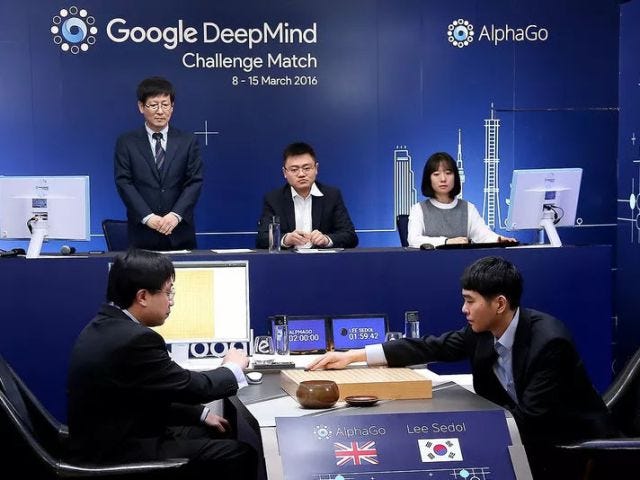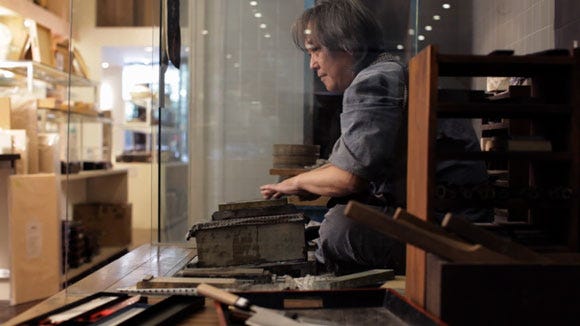Random finds (2016, week 11) — On conversational intelligence, collaboration and AI beyond Go

Every Friday, I run through my tweets to select a few observations and insights that have kept me thinking over the last week.
Conversation: the most underused innovation tool
In an interview with Entrepreneur.com’s Linda Lacina, Judith Glaser, an organizational anthropologist, talked about her fascination for understanding the ‘why’ behind when conversations go well and when they don’t. A discipline she calls ‘conversational intelligence.’
Glaser talks about the importance of listening — not listening to judge or reject, but listening to connect — and of building trust to allow people to have meaningful and transformative conversations. “Culture is an abstract term,” she says. “Greatness depends on the quality of culture, depends on the quality of relationships, depends on the quality of conversations.”
She also shares her thoughts on the three different levels of conversation. Level 1 or transactional conversations in which we confirm what we already know. Level 2 or positional conversations in which we take a stand and advocate. And finally, level 3 conversations during which people exchange energy to explore new ideas — to discover thing we don’t know yet and synthesize and share new ideas.
“Most people listen to find a place to put their thought in.” — Judith Glaser
You can listen to the 30-minute interview here.
The collaboration curse
“In modern business, collaboration is next to godliness,” Schumpeter writes in The Economist in response to Collaborative Overload (Rob Cross, Reb Rebele and Adam Grant in Harvard Business Review, January-February 2016).
“Firms shove their staff into open-plan offices to encourage serendipitous encounters. Managers oblige their underlings to add new collaborative tools such as Slack and Chatter to existing ones such as e-mail and telephones. Management thinkers urge workers to be good corporate citizens and help each other out all the time.”
And although this fashion for collaboration makes some sense, it makes ‘deep work’ — “the killer app of the knowledge economy,” as Schumpeter calls it — difficult, if not impossible. A succession of studies have shown that multitasking reduces the quality of work as well as dragging it out. Jumping rapidly from one task to another also reduces efficiency because of what is called ‘attention residue’. The mind continues to think about the old task even as it jumps to a new one.
One of the reasons why organisations have been so naive about collaboration is that collaboration is much easier to measure than ‘deep work’. “Any fool can record how many people post messages on Slack or speak up in meetings, whereas it can take years to discover whether somebody who is sitting alone in an office is producing a breakthrough or twiddling his thumbs,” Schumpeter writes.
Helping people to collaborate is a wonderful thing. Giving them the time to think is even better.
To restore balance in a world gone collaboration-mad, organisations need to do more to recognise that the amount of time workers have available is finite, that every request to attend a meeting or engage in an internet discussion leaves less time for focused work and that seemingly small demands on people’s time can quickly compound into big demands.
Go DeepMind, go
It was almost impossible to miss Google DeepMind’s endeavors against Lee Sedol, the worlds top Go player. Despite all the jubilation, Scott Smith struck a cord when he wrote that “The terms ‘artificial intelligence’ and ‘AI’ are being attached to practically anything that can respond to a database query at the moment, rendering the definition of what constitutes intelligence in machine form functionally meaningless.”
According to Smith, Google’s AlphaGo matches of human player vs machine have been reported and retweeted with oohs and aahs about the creativity of AlphaGo’s play. But is applying a novel combination of possible moves or working through an instruction set — even though highly complex and adaptive — truly creative?
“My point,” Smith writes, “isn’t to set out firm definitions, but to ask if the conversations around these definitions are settled to the point where developers and marketers can claim victory and move on. […] But don’t we lose a bit (or a lot) when we let sloppy definitions slide through? How do we know when the real achievements have been made?”

Creative or not, beating humans is one thing, but to really succeed AI must work with them, Michael Cook, an AI researcher at Goldsmiths, University of London, claims in The Guardian.
“We have to treat AI like cold, hard science, but we are also compelled to engage with it as a shared social concept. AI is not just the algorithms and the data, the models and the results,” Cook writes. “It’s our collective understanding, as a society, of the things technology can do, the things it can’t yet do, and then AI — the stuff that happens where those things meet.”
Cook argues we should be more ambitious about what we want from AI in order to mediate that strange space between what people understand technology to be capable of, and what is thought to be impossible. “As we marshall Go across that gap from impossible to possible, it’s time to look at what’s next. I hope we can make a good choice,” he writes. However, tackling yet another game — DeepMind tells us that StarCraft will be their next target — might not be the kind of decision Cook is hoping for.
In Go, one of the most interesting things is how the spaces left empty on the board can often be as important and meaningful as the spaces where stones are played.
In AlphaGo, Lee Sedol, and the Reassuring Future of Humans and Machines (The New Yorker), Eric Haseltine, a longtime technology researcher and a veteran of the National Security Agency, NSA, says that “We tend to think of AI as a problem-solver. What if the best use of AI is as a problem-finder?” Consider an issue like climate change. “We, as humans, as neurons, as selves, will never and can never figure it out,” he said. “But will we as a hybrid of AI and humans figure it out?”
During AlphaGo’s match with Lee Sedol, the program’s physical moves — it has no hands, after all — were played by Aja Huang, a member of the DeepMind team and a strong amateur Go player himself. In many ways, Huang embodied a possible methodological future for AI: for a given set of problems, we will require AI’s help, but it will also require ours.
A few of the many, many articles and posts:
- In the age of Google DeepMind, do the young Go prodigies of Asia have a future? in The New Yorker.
- The very human implications of self-taught AI playing the world’s hardest game in Quartz.
- Google’s AI Takes Historic Match Against Go Champ With Third Straight Win in WIRED.
- Does a Computer Beating The World Go Champion Matter? by Dave Aron.
A bit more …
In Should All Research Papers Be Free (New York Times), Michael Eisen, a professor of genetics, genomics and development at the University of California, Berkeley, and a longtime champion of open access, argues that the leaders of the scientific community — Nobel scientists, heads of institutions, the presidents of universities — are themselves the biggest barrier to open access publishing.
“[They] have never faced up to this problem in part because they are beneficiaries of the system. University presidents love to tout how important their scientists are because they publish in these journals.”
In Is Design Thinking a Fairytale, Maureen Thurston, Global Design to Innovate Director at Aurecon, writes: “Systems thinking. Integrative thinking. Design Thinking. Left brained. Right brained. Whole brained. The character of our thinking seems to be the new competitive currency.”
“Design Thinkers have a certain disposition,” she continues. “A mind-set that doesn’t get flustered by ambiguity — it’s inspired by it! They’re obsessed with imagining what might be possible — driven to challenge the status quo. Design Thinkers take a holistic approach to understanding the problem from multiple angles and stakeholder perspectives. It’s a belief system that if you explore the shadows, you’ll uncover the underserved need, the unique opportunity.”
Read here: http://justimagine.aurecongroup.com/is-design-thinking-a-fairytale.
More on design thinking in Deloitte University Press’ Global Human Capital Trends 2016 report that explores 10 talent-related issues that are having a profound impact on the way organizations approach people management.
“Design thinking takes aim at the heart of unnecessary workplace complexity by putting the employee experience first — helping to improve productivity by designing solutions that are at once compelling, enjoyable, and simple.”
“The data from our survey this year suggest that the more importance an organization places on design thinking and the more ready it is to embrace it, the faster the organization grows.”
On Egde, a conversation with Howard Gardner about liberal arts and sciences in the 21st century.
“I want to ensure that people in the world have an education where they are informed and enthusiastic about the pursuit of truth, beauty, and goodness.”
“Here’s something that almost drove me nuts. I was talking to a wonderful Harvard freshman, a wonderful kid, about four years ago and I was trying to interest him in something. He said, ‘You know, Dr. Gardner, I’m not interested in questions for which there are no answers.’ And I said, ‘That’s the only reason for going to college. That doesn’t mean you can’t make progress, but if you’re only going to take a course where they’re going to tell you the answers, you should go to some other place’.”
Listen here: https://www.edge.org/conversation/howard_gardner-liberal-arts-and-sciences-in-the-21st-century.
In Recipe for success (Aeon), Julian Baggini, philosopher and founding editor of The Philosophers’ Magazine, asks who we should admire more: the Michelin-starred chef with his teams and glamour, or the unsung but brilliant cook?
“Fame is relative, of course,” Baggini writes. “Most of us can honestly say we have no desire to be on the cover of Hello! magazine, yet almost all of us crave recognition, believing that it validates our endeavours. A myth of our age is that talent, dedication and ambition bring such recognition — and its associated rewards — in gastronomy as in everything else.”
“The message is clear: you should do what you do to the best of your ability, and whether you gain recognition for it or not is secondary. This is the ethic of the Japanese ‘shokunin’, the true craftsman. These masters are completely dedicated to perfecting their craft, whether it is cookery or calligraphy, woodwork or weaving. Honour comes simply from the work, not from the recognition others give you for your doing it.”
Read here: https://aeon.co/essays/is-success-in-the-eye-of-the-beholder-or-an-inner-feeling.

“I never dreamt that with my own two hands I could touch the sky.” — Seymour Bernstein in Seymour: an introduction.
